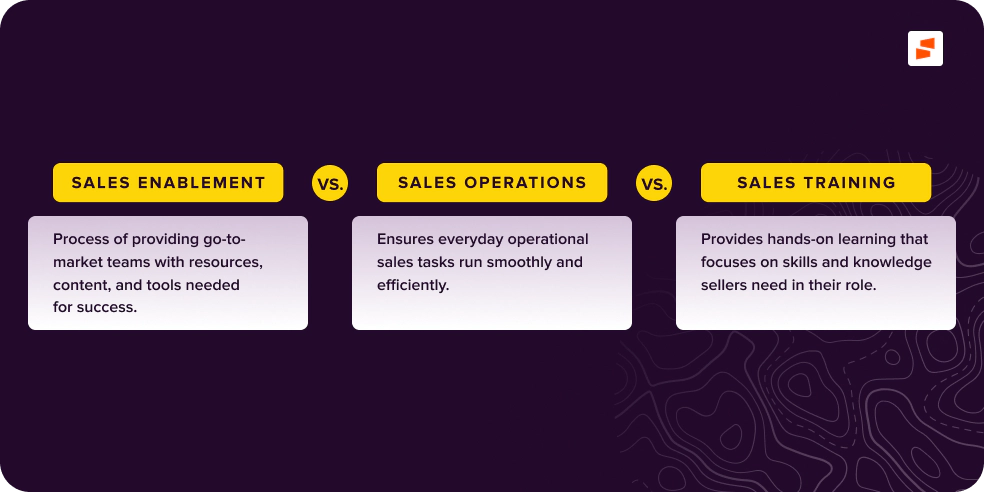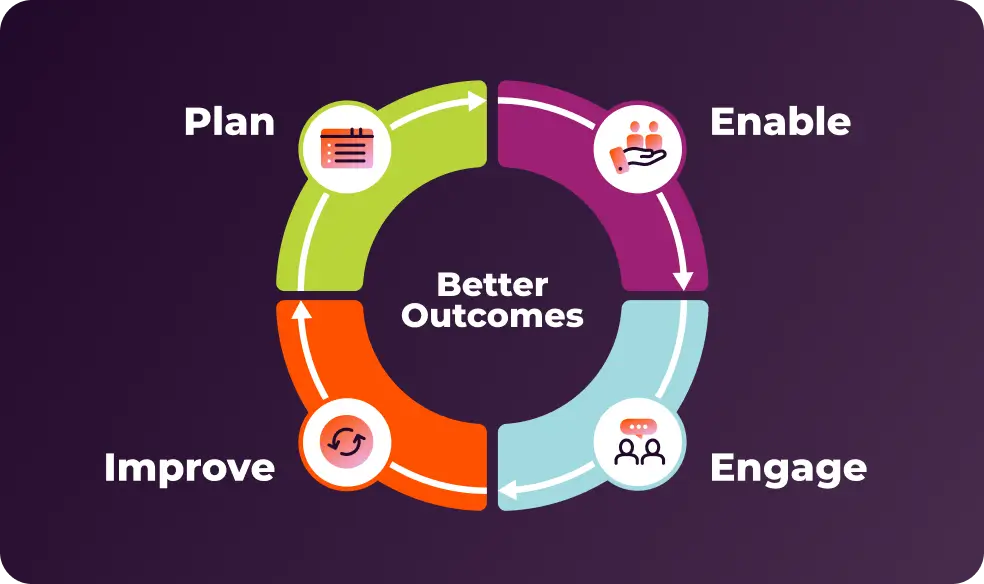Understanding sales enablement
What is sales enablement?
We define sales enablement as a strategic approach to selling that aligns content, training, and tools with the buyer’s journey. What brings sales enablement meaning is its ability to bridge the gap between sales and marketing. It’s designed to ensure every buyer interaction is impactful and aligned with the overall business goals.
Here’s how some of the top industry experts define it:
- A cross-functional discipline to increase sales results through better content, training, and coaching (CSO Insights).
- A system of activities, processes, and tools that support knowledge-based buyer interactions (Gartner).
- An ongoing process to ensure your reps can have valuable conversations with the right people at the right time. (Forrester).
The rise of sales enablement
Sales enablement has come a long way since its early days in the 2000s. It was a simple support function, helping sales teams keep up with longer, more complex B2B sales cycles. Today, it’s a strategic must-have for navigating savvy buyers, cross-functional decision-makers, and stiff competition.
Here’s a snapshot of how sales enablement has evolved:
- 2017: Just 58% of companies had a dedicated sales enablement function.
- Now: Over 80% of organizations have made enablement a top strategy.
- New roles: ‘Sales enablement specialist’ is one of the fastest-growing job titles on LinkedIn.
What’s driving this growth? Companies are realizing that enablement isn’t solely to support sales. Enterprise sales enablement strategies for larger organizations drive results across the entire go-to-market (GTM) function. With advancements in artificial intelligence and cutting-edge tools, sales enablement is entering an exciting new era of innovation and impact.
The importance of enablement in 2025
The sales landscape has shifted — buyers expect tailored, value-driven experiences at every touchpoint. To keep up, sales teams need more than great products; they need the right tools, training, and strategies to deliver meaningful interactions. That’s where sales enablement comes in.
Investing in sales enablement helps organizations:
- Streamline processes and increase seller productivity.
- Drive better buyer engagement with tailored content and coaching.
- Increase win rates, deal sizes, and time spent selling.
In 2025, sales enablement isn’t just nice to have; it’s the backbone of a competitive, buyer-first strategy.
Did you know?
Sellers spend an average of 10 hours per week tracking down, comparing, or revisiting content to send to buyers.
Sales enablement responsibilities
Behind every successful sales enablement strategy is a dedicated team working to empower sellers and drive results. Depending on the size and structure of the organization, the team might include a:
- Sales Enablement Manager: Think of this role as the quarterback. It’s someone who leads enablement strategies, oversees training, and ensures resources align with the company’s goals.
- Content Strategist: Responsible for crafting the content reps rely on, from pitch decks to buyer guides, all tailored to resonate with today’s informed buyers.
- Sales Trainer: Focused on upskilling the team through sales coaching and training programs that keep reps sharp and confident.
Sales enablement teams and roles
Behind every successful sales enablement strategy is a dedicated team working to empower sellers and drive results. Depending on the size and structure of the organization, the team might include a:
- Sales Enablement Manager: Think of this role as the quarterback. It’s someone who leads enablement strategies, oversees training, and ensures resources align with the company’s goals.
- Content Strategist: Responsible for crafting the content reps rely on, from pitch decks to buyer guides, all tailored to resonate with today’s informed buyers.
- Sales Trainer: Focused on upskilling the team through sales coaching and training programs that keep reps sharp and confident.
In smaller organizations, these responsibilities might fall to one or two people. Larger enterprises, however, often dedicate entire teams to enablement, with specialists for each role.
No matter the size of the team, their mission is the same: to empower sales reps to perform their best and achieve outstanding results.
Sales enablement vs. sales operations vs. sales training
Sales enablement and sales operations share a common goal: supporting sales teams. However, their approaches differ:
- Sales enablement: Think of this as the big-picture strategist. It’s all about aligning people, processes, and tools to help reps connect with buyers and close deals.
- Sales operations: The behind-the-scenes organizer. This team (or person) focuses on the logistics and day-to-day processes that support the sales team, such as CRM management and lead optimization.
- Sales training: The teacher. This function equips reps with the skills, information, and strategies that help close deals. This takes form in onboarding and ongoing sales training.
To put it simply:
- Sales operations handle the “how” — managing the day-to-day processes.
- Sales enablement tackles the “why” — creating strategies to drive meaningful results.
- Sales training builds the “what” — teaching the skills and tactics needed to succeed.

Stakeholders and cross-collaboration
Who owns sales enablement? Ownership typically lies with the sales enablement team. But, success largely depends on effective collaboration among key stakeholders:
- Sales teams: The frontline heroes who rely on enablement tools and strategies to connect with buyers and close deals.
- Marketing teams: The content creators who craft material tailored to buyer needs and make sure sellers have everything they need.
- Sales enablement teams: The bridge builders, aligning marketing and sales enablement efforts to keep everyone moving toward shared goals.
- Leadership: The decision-makers who provide strategic direction, resources, and accountability for enablement projects.
What ties these groups together? A commitment to shared outcomes, like higher conversion rates and increased time spent selling. When everyone collaborates, sales enablement becomes more than a function — it becomes a driver of success for the entire organization.
How to develop a sales enablement strategy
Creating a successful sales enablement strategy takes thoughtful planning, team collaboration, and a commitment to growth. Here’s how to get started:
1
Plan with purpose
2
Equip and empower
3
Engage your team
4
Refine and grow
With the right strategy, sales enablement becomes a powerful force for driving team productivity, buyer engagement, and revenue growth.
Ensure alignment with business goals
For enablement to succeed, align it with your organization’s larger goals. Here’s how to make sure your efforts stay focused and effective:
- Tie it to measurable outcomes: Track KPIs like win rates and time spent selling to evaluate success.
- Why it matters: Tracking these metrics helps you prove the value of enablement to the entire organization.
- Foster collaboration across teams: Schedule regular check-ins between sales and marketing to ensure messaging consistency.
- Pro tip: Monthly alignment meetings are a great way to review progress and troubleshoot challenges together.
- Get leadership buy-in: When leadership is involved, enablement becomes a top priority. Engage them early by showing how your initiatives support revenue goals and overall business success.
- Why it works: Securing leadership support ensures you’ll have the resources and accountability to keep your strategy on track.
Examples of effective sales enablement strategies
HubSpot increases rep productivity
By centralizing content and integrating training with Seismic, HubSpot saved reps an estimated two hours per week, generating $18M in efficiency gains. The bonus? Better collaboration across sales and customer success teams.
Rob Giglio
Chief Customer Officer
Zixi transforms onboarding
Zixi used Seismic to streamline onboarding with tailored learning journeys, reducing ramp times and ensuring consistent, role-specific training across global teams. The result? Greater efficiency as a sales organization and bolstered adaptability to meet the business’ priorities.
Eric Mingorance
Senior Director of Sales & Field Enablement
The benefits of sales enablement
Sales enablement is a strategy that changes how sales teams operate and drive results. By equipping sellers with the right tools, content, training, and processes, organizations achieve:
Improved sales productivity
Sales enablement tools cut through the noise, giving your team more time to focus on what matters: connecting with buyers.
Stronger buyer engagement
When sales reps provide tailored insights that align with their business needs, prospective clients are 57% more likely to engage.
Alignment across teams
Organizations with aligned sales and marketing teams see higher customer retention.
Higher win rates
What could a 23% bump in win rates do for your bottom line? With enablement, your team doesn’t just close more deals, they close bigger ones.
Scalable success
Enablement programs cut new hire ramp time in half and improve continuous learning.
Specific, measurable advantages of sales enablement
- Increased efficiency: Sales enablement tools streamline access to content, allowing reps to spend less time searching and more time engaging with buyers.
- Revenue impact: Enablement improves win rates, which directly increases revenue and business growth.
- Buyer confidence:High-quality, relevant content plays a role here too. In fact, 95% of buying decisions are directly influenced by content.

Sales enablement tools
Sales enablement solutions include a range of tools and platforms designed to support sales teams. They’re focused on: driving engagement, productivity, and revenue. Here are some key sales enablement tools and their benefits:
- Content management systems (CMS): Imagine this: your reps never waste time digging through outdated decks or files. With a central, sales content hub, every resource is at their fingertips.
- Sales training and coaching platforms: Deliver ongoing training and coaching to sales reps. Continuous learning and skill development are critical for keeping reps at the top of their game. Personalized training modules make sure every rep is equipped to perform effectively.
- Buyer engagement tools: These tools enable sellers to close deals, and more importantly, build lasting customer relationships.
- Sales analytics and business intelligence tools: Advanced analytics help teams spot trends, measure performance, and make data-driven decisions.
- Strategy and planning tools: Strategic planning tools simplify the way teams set priorities, improve workflows, and ensure every effort aligns with overall business goals.
Emerging sales enablement trends and innovations
Sales enablement is evolving rapidly, driven by tech advancements and shifting buyer expectations. These innovations empower teams to work smarter, connect more deeply with buyers, and achieve greater results. Here are some of the key trends reshaping the enablement landscape:
- Artificial intelligence (AI) integration: AI is changing the game. Think fewer spreadsheets and more time for high-value conversations. From lead scoring to forecasting, savvy enablement organizations are leaning on AI to optimize their workflows and automate what they can.
- Conversational interfaces: Chatbots and virtual assistants improve real-time buyer interactions.
- VR/AR for immersive experiences: Create engaging product demonstrations that help buyers visualize solutions.
- Emotion AI: What if you could read between the lines of buyer conversations? Emotion AI analyzes tone and sentiment to refine your sales messaging.
The future of enablement
The future of sales enablement lies in integrating AI and emerging technologies. In The 2023 Value of Enablement Report, 80% of respondents who use enablement technology said it frees up time to focus on revenue-generating activities — and AI only frees up even more time.
In another recent study on The State of AI in Enablement, 83% of respondents said fusing AI and GTM strategy would lead to revenue growth. In short, companies that embrace AI-based innovations in their enablement will gain a competitive edge by:
- Improving forecasting accuracy through predictive analytics.
- Reducing manual tasks with AI-powered automation.
- Creating immersive, personalized buyer experiences.
Best practices for implementing sales enablement in your organization
Successful sales enablement requires careful planning, effective execution, and continuous improvement. Here are the best practices to ensure enablement initiatives drive results:
- Align with organizational goals
- Collaborate with leadership to align enablement initiatives with business goals like revenue growth, customer retention, and team productivity.
- Establish KPIs to measure progress, such as time spent selling, win rates, and deal size.
- Foster cross-department collaboration
- Ensure alignment between sales, marketing, and enablement teams to create consistent messaging and shared accountability.
- Regularly meet with stakeholders to review progress and adjust strategies as needed.
- Customize training and tools
- Tailor enablement programs to the unique needs of your sales team, considering their roles, buyer personas, and target markets.
- Use analytics to identify skill gaps and provide personalized training.
Maximizing adoption and effectiveness
- Gain executive buy-in: Leadership support is crucial for securing resources and driving team-wide adoption. Communicate the value of enablement programs by tying them to measurable business outcomes.
- Simplify access to resources: Provide a single source of truth for sales content, tools, and training materials. Ensure resources are easy to find and optimized for quick use during the sales process.
- Incentivize participation: Make enablement irresistible. Reward your team for adopting new tools and techniques. Turn participation into enthusiasm.
Overcoming common challenges
- Challenge: Lack of cross-department alignment
- Solution: Establish regular communication channels between sales, marketing, and enablement teams. Use shared metrics to drive accountability.
- Challenge: Resistance to change
- Solution: Roll out enablement initiatives gradually and communicate the benefits. Use early success stories to encourage adoption.
- Challenge: Inconsistent use of tools and content
- Solution: Train teams on new tools and create easy-to-follow processes to ensure consistency. Regularly audit content and tools to make sure everything is stays current and relevant.
Measuring the impact of enablement
It can be especially challenging to measure the impact of your sales enablement efforts. Sales enablement analytics tie initiatives to specific business outcomes, such as increased deal size, higher win rates, and reduced ramp time for new hires. Measure the impact of sales enablement using:
- Adoption rates
- Track usage of enablement tools and resources. High adoption indicates relevance and usability.
- Performance metrics
- Monitor KPIs like win rate and quota attainment.
- Content effectiveness
- Use analytics to track which content drives engagement and advances deals.
Never stop growing.
Enable your sales team with Seismic
Sales enablement is the key to helping your sales team achieve its full potential. By equipping your sellers with the right tools, content, and training, you can see measurable improvements in productivity, buyer engagement, and revenue growth.
The Seismic Enablement CloudTM is the most powerful, unified sales enablement platform that equips customer-facing teams with the right skills, content, tools, and insights to grow and win. Ready to future-proof your sales team? See how Seismic can help you stay ahead and win more. Get a demo today.



